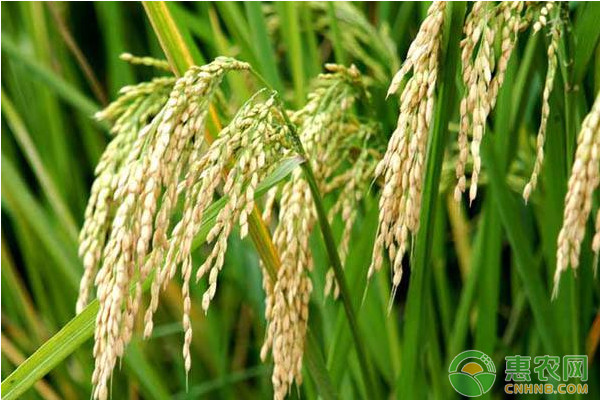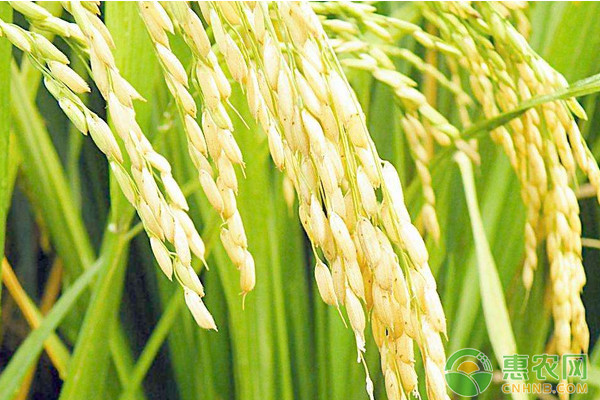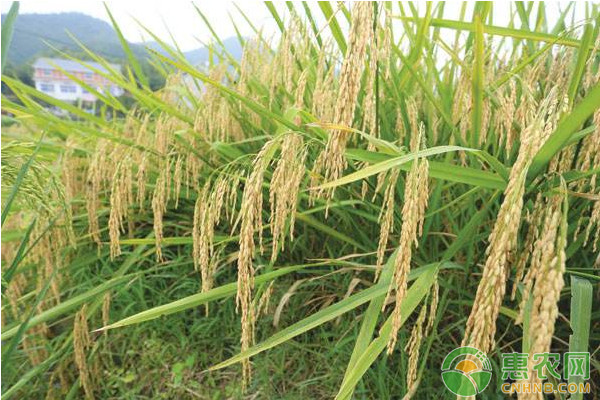Today, Huinong.com will introduce a variety of planting techniques, namely “Yuyou 127â€, which is a high-quality hybrid japonica rice, which is a research institute of Rice Sorghum Research Institute of Sichuan Academy of Agricultural Sciences. It belongs to the main varieties of Sichuan high-quality engineering, the national standard second-grade rice, suitable for a wide range, medium and early maturity, easy to grab the season, new rice morning market.
1 General requirements
1.1 Origin environment
Should comply with the provisions of NY 5116-2002. Paddy soil, atmosphere and irrigation water must be pollution-free, and there must be no sources of pollution in the surrounding areas.
1.2 Principles of fertilizer use
The principles of fertilizer use should be in accordance with NY/T 496. It is forbidden to use chemical and biological fertilizers that have not been registered by the national or provincial agricultural departments; it is forbidden to use fertilizers (organic fertilizers and mineral fertilizers) with excessive levels of heavy metals. The safe drainage period for fertilizer use (the number of days that it is difficult to drain after applying fertilizer in rice fields) is 7 days.
1.3 Principles of pesticide use
The use of pesticides should meet the requirements of GB 4285 and GB/T 8321. Efficient, low-toxic, low-residue pesticides should be used to promote the use of biological pesticides. It is strictly forbidden to use highly toxic, highly toxic, high-residue and tri-toxic (carcinogenic, teratogenic, mutagenic) pesticides.
Correctly master the appropriate period of application, the right medicine, advocate a multi-drug treatment, the concentration and dosage should be appropriate to prevent blind increase in drug concentration and increase the amount of medication. Pay attention to the time and method of application. It is best to apply the medicine on cloudy or sunny days in the morning and evening. According to the type of pests and diseases and the hazardous parts on the crops, pesticides should be used in the key areas, and the agents with different mechanisms should be alternately rotated. Overcome and delay the occurrence and development of pest and disease resistance.
The safe drainage period after pesticide application is 5-7 days. The maximum number of pesticides used and the safety interval are strictly in accordance with the instructions.
1.4 Pest Control Principles
Carry out the plant protection policy of “prevention first, comprehensive preventionâ€, and comprehensively apply measures such as agricultural control, biological control, physical control and chemical control to control the occurrence and harm of harmful organisms from the stability of rice paddy ecosystem.
2 Cultivation techniques
2.1 Reasonable close planting
2.1.1 Direct seeding rice
The seeding amount of direct seed hybrid rice is 2 - 2.5 kg per mu, and the conventional rice is 3-4 kg. Seeds coated with bio-coating agents are advocated to prevent underground pest damage. Pay attention to the quality of the seeding to ensure the whole seedling. After seeding and emergence, timely and densely fill the gap.
2.1.2 Transplanting rice
In the single-season transplanted rice in Sichuan, the planting density is generally 1.2-1.7 million, the hybrid rice planting 1-2, and the conventional rice planting 3-4. Promote wide-row narrow plants or wide and narrow rows of plants.
2.2 Balanced fertilization
It advocates soil testing and formula fertilization, organic and inorganic combination, and nitrogen, phosphorus and potassium fertilizers are combined. Generally, the ratio of organic nitrogen to inorganic nitrogen is 1:1, and nitrogen: phosphorus: potassium (N: P2O5: K2O) is 1:0.5:1. Strictly control the amount of nitrogen applied and the type of nitrogen fertilizer. The amount of pure nitrogen (N) per acre of single-season rice is less than 14 kg, and nitrate nitrogen fertilizer is banned.
Nitrogen fertilizer generally uses 50-70% as base (bottom) fertilizer, 20-30% as split fertilizer, 10-20% as panicle fertilizer; phosphate fertilizer is used as base fertilizer; potassium fertilizer base fertilizer and manure fertilizer each account for 50%. The base fertilizer requires deep application, and the organic fertilizer is used as the base fertilizer.

2.3 Reasonable irrigation
2.3.1 Irrigation water quality requirements
Should comply with the provisions of NY 5116-2002.
2.3.2 Irrigation methods
During the regreening period, the shallow water layer is maintained, and the irrigation is carried out during the tillering period. When the number of seedlings reaches 80-90% of the estimated number of panicles, the field is exposed and exposed to the field, and multiple light exposures are adopted to control the ineffective tillering, promoting root growth and strong growth. Strain. After the ear differentiation, the water is filled and the shallow water layer is maintained until the heading and flowering stage. Intermittent irrigation from grouting to maturity, alternating wet and dry. Water was cut off about 7 days before harvest.
3 pest control technology
3.1 Agricultural control
3.1.1 Select varieties with strong resistance, and rotate the varieties regularly to maintain the resistance of the varieties and reduce the occurrence of pests and diseases.
3.1.2 Adopt agronomic measures such as rational farming system, rotation for cropping, combination of breeding and breeding (rice duck, rice fish, rice and crab, etc.), fitness cultivation (scientific irrigation and drainage, improvement of field microclimate), and reduce the occurrence of harmful organisms.
3.2 Biological control
Use medium and low-toxic pesticides with low lethality to natural natural enemies to create an environment suitable for natural enemies to breed or artificially release natural enemies (such as Trichogramma to control aphids) to control the occurrence of harmful organisms. Bio pheromones (such as sex attractants) can be used to control pests.
3.3 Physical control
The seeds are soaked in warm water soaking seeds, and the physical devices such as black light, frequency vibration lamp and chromatic light plate are used to trap Lepidoptera and Homoptera pests.
3.4 Chemical control
3.4.1 Prevention and treatment of major diseases
3.4.1.1 Rice blast
According to the provisions of GB/T 15790, when the central disease group of rice blast occurs, spray treatment with tricyclazole per acre; bio-pesticide can be controlled with Bacillus subtilis wettable powder or Chunremycin water. It is recommended to transplant with medicine, that is, 3-5 days before transplanting, using 75% tricyclazole wettable powder and 40% chlorpyrifos EC to carry out the spray on the field, can effectively prevent rice blast and first generation aphids.
3.4.1.2 Rice sheath blight
According to the provisions of GB/T 15790, when the incidence rate of tillering plexus is 15-20%, and the booting period is more than 30%, the injection of Jinggangmycin and benzoylpropanazole for the middle and lower part of the rice plant can be used for bio-pesticide. The selection of the grain is clean, which can simultaneously prevent rice smut.
3.4.1.3 Rice false smut
In the middle and late stages of the booting (before and after the breakage period), the panicles were sprayed with a fine mist to prevent and cure the panicles with benzazole or bio-pesticide.

3.4.2 Prevention and control of major pests
3.4.2.1 Chilo suppressalis
According to GB/T 15792 and NY/T 59, in the peak period of the sheath, spray control with insecticidal or chlorantraniliprole, bio-pesticide can use Bacillus thuringiensis wettable powder. Special attention should be paid to the use of insecticidal double insecticides in sericulture areas. Pay attention to the heart after the booting, and prevent the second generation of phlegm.
3.4.2.2 Sanhua
Master the initial period of hatching of eggs, and start the chemical control when the amount of eggs per mu is more than 50. The type of the drug is the same as that of the cockroach.
3.4.2.3 Rice leaf roller
According to the provisions of GB/T 15793, master the germination period of 1st and 2nd instar larvae (in the early stage of rice leaf). When the tillering period of the plexus larvae reaches 65-85 heads and the booting stage is 40-60 heads, the medicaments are controlled, and the medicinal varieties can be chlorpyrifos, insecticidal doubles, and insecticidal tablets.
3.4.2.4 Insect horse
In the seedling stage, when the leaf tip curling rate was above 10% and the strain of the worm was more than 300-500 heads, the leaf spray was controlled by imidacloprid.
3.4.2.5 Rice planthopper
According to the provisions of GB/T 15794, when the amount of worms reaches 1500-2000 heads, the use of buprofezin or imidacloprid for spray control of the middle and lower part of the rice plant per acre can be used as a bio-pesticide.
3.4.3 Weed control
3.4.3.1 Control of weeds in Putian
Spraying with bensulfuron-methyl for 0-10 days after sowing.
3.4.3.2 Control of Honda Weeds before and after transplanting
5-10 days after transplanting, after the seedlings return to green, they are mixed with pyrazosulfuron and mixed with water or sprayed with water.
3.4.3.3 Live field weed control
The direct seeding rice field is carried out by the method of “one extinction, two seals, three divisions and four supplementsâ€. 5-10 days before sowing, the killing herbicide (such as benzyl acetochlor) is used to kill the whole field; 1-4 days after sowing, the pre-emergence herbicide (such as broom) is used for closure; after sowing 20 Weeding with selective herbicides (such as Daojie) around the day; artificial weeding is recommended after weeds 5 leaves.
4 Harvest, transportation, storage and by-product processing requirements
4.1 Harvest
Harvest at the right time, implement green high-quality rice and ordinary rice collection and distribution. It is forbidden to thresh and sun-treat in places where roads, asphalt roads and dust pollution are serious.
4.2 Transportation
The means of transport should be clean, dry and protected from rain. It is strictly forbidden to mix with toxic, harmful, corrosive and odorous items.
4.3 Storage
Store in a place protected from light, ambient temperature, dryness and moisture-proof facilities. Storage facilities should be clean, dry, ventilated, free of pests and rodents. It is strictly forbidden to mix with toxic, harmful, corrosive, prone to mildew, moisture, and odor. If the warehouse is disinfected and fumigated, the chemicals used should comply with the national food safety and safety regulations.

4.4 By-product processing
The by-products of pollution-free rice production, including straw, chaff, rice bran, etc., should be comprehensively developed and rationally used; in advance, the straw should be returned to the field, and it is strictly forbidden to incinerate, pile up, discard and pollute the environment.
Suitable area:
It is suitable for the Chengdu Plain in Sichuan and the hilly area below 900 meters above sea level.
Precautions:
Green agricultural products shall be subject to the management mode of origin certification and product certification. Production units and individuals shall apply for certification to the county-level agricultural administrative department and the National Certification and Accreditation Administration and its authorized certification body.
The above is the whole content of high-quality rice "Yuyou 127" green high-efficiency planting technology. It is said that the current green planting mode is used, the price of rice reaches 3 yuan / kg, and the income per acre is 700-900 yuan.
Suction Breast Pump,Abs Breast Pump,Phthalate Free Breast Pump,Memory Function Breast Pump
NINGBO YOUHE MOTHER&BABY PRODUCTS CO.,LTD , https://www.oembreastpump.com